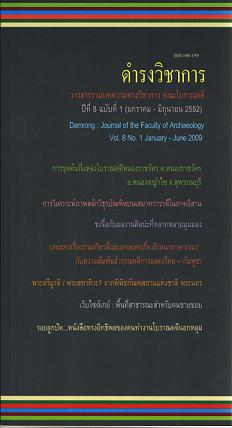A NEW INTERPRETATION OF VIDHURAPANDITA – JATAKA SCENE IN BOUNDARY MARKER STONE FROM NORTHEASTERN THAILAND
Keywords:
ภาพสลัก, เสมา, ทวารวดีAbstract
Sema or boundary marker stone, founded to bound the scared area, was the local tradition of the Dvaravati culture in the Northeast of Thailand which differed from the Dvaravati’s manner in the central. Dvaravati’ssemas were spead throughout many part of Northeastern Thailand, some part in the central of Thailand, Cambodia, and Laos. Many of them are carved sandstones which depicted the scene according to Buddhist’s text as well as the act of Buddha, jakatas, an auspicious thing such as stupa, Dharmmacakra, and the full water pot (Puranaghata).The Dvaravati’sSema carving from Northeastern Thailand depicted the narrative of Vidhurapandita-Jakata was selected to study. The Vidhurapandita-Jakata is the ninth birth of the Buddha from the ten significant reincarnations. This Jakata narrated Bodhisattva who was born to be Vidhurapandita, the minister of King of Indapatta, for practicing truthfulness or Saccaparami. He regularly preached to the king and his valueable sermon made the mischievous demon repented of wrong doing. There were three scenes of Vidhurapandita in the Sema that study. Firstly, the scene of Vidhurapandita was abducted by Punnakayaksa, the demon. This scene demonstrated as Punnakayaksa Demon sat on the back of magical horse and Vidhurapandita was holding a horse’s belly while the horse ran up through the heavens. Secondly, this scene was found only one specimen from WatBanma, Sakolnakorn and was interpreted as a scene of Ramayana. From this study, this scene interpreted to be the scene of Punnakayaksa Demon tried to throw Vidhurapandita down to the vale, attempted to kill the Bodhisattva. Thirdly, Vidhurapanditawae preaching to Punnakataksa Demon, this scene was very famous and could be confused with the scene of The Great Departure of the Buddha’s act. In this study, there were some details from the scene such as the posture of the Adoration of the Character, to support the interpretation of the three Vidhurapandita-Jakata scenes of the Dvaravati’sSema carving.
Downloads
Issue
Section
License
บทความนี้เป็นผลงานของข้าพเจ้าแต่เพียงผู้เดียว และ/หรือเป็นผลงานของข้าพเจ้าและผู้ร่วมงาน ตามชื่อที่ระบุในบทความจริง และเป็นผลงานที่มิได้ถูกนำเสนอหรือตีพิมพ์ที่ใดมาก่อน




